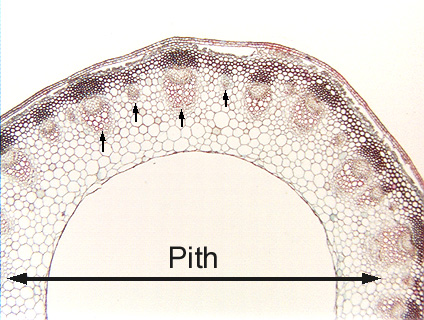|
[Home]
[Up]
| |
 Fig.
11.4-4. Transverse section of delphinium stem (Delphinium ajacis).
This delphinium stem is a good example of a stem in which the pith breaks down.
The pith extends from the innermost protoxylem on one side of the stem to the
innermost protoxylem on the other side, as far as the arrow extends. Not
all the pith has been torn apart; the perimedullary region – a layer about
five or six cells thick -- has elongated enough to keep up with the expansion of
the rest of the stem tissues, so it is intact. Fig.
11.4-4. Transverse section of delphinium stem (Delphinium ajacis).
This delphinium stem is a good example of a stem in which the pith breaks down.
The pith extends from the innermost protoxylem on one side of the stem to the
innermost protoxylem on the other side, as far as the arrow extends. Not
all the pith has been torn apart; the perimedullary region – a layer about
five or six cells thick -- has elongated enough to keep up with the expansion of
the rest of the stem tissues, so it is intact.
The small arrows indicate four of the many vascular bundles. Some bundles
are so large that the vessels in their xylem are visible even at this low
magnification, other bundles are so small the entire bundle is scarcely visible.
Many monocots also have hollow stems (grasses for example), and often so much
conjunctive tissue breaks down that there is only enough room left for one ring
of bundles. In such monocot stems, the atactostele can then be easily mistaken
for the eustele of a dicot. If your anatomy lab uses wheat (Triticum) as
teaching slides, you may run into this (hint to students – professors like to
use this on lab tests).
|
 Fig.
11.4-4. Transverse section of delphinium stem (Delphinium ajacis).
This delphinium stem is a good example of a stem in which the pith breaks down.
The pith extends from the innermost protoxylem on one side of the stem to the
innermost protoxylem on the other side, as far as the arrow extends. Not
all the pith has been torn apart; the perimedullary region – a layer about
five or six cells thick -- has elongated enough to keep up with the expansion of
the rest of the stem tissues, so it is intact.
Fig.
11.4-4. Transverse section of delphinium stem (Delphinium ajacis).
This delphinium stem is a good example of a stem in which the pith breaks down.
The pith extends from the innermost protoxylem on one side of the stem to the
innermost protoxylem on the other side, as far as the arrow extends. Not
all the pith has been torn apart; the perimedullary region – a layer about
five or six cells thick -- has elongated enough to keep up with the expansion of
the rest of the stem tissues, so it is intact.